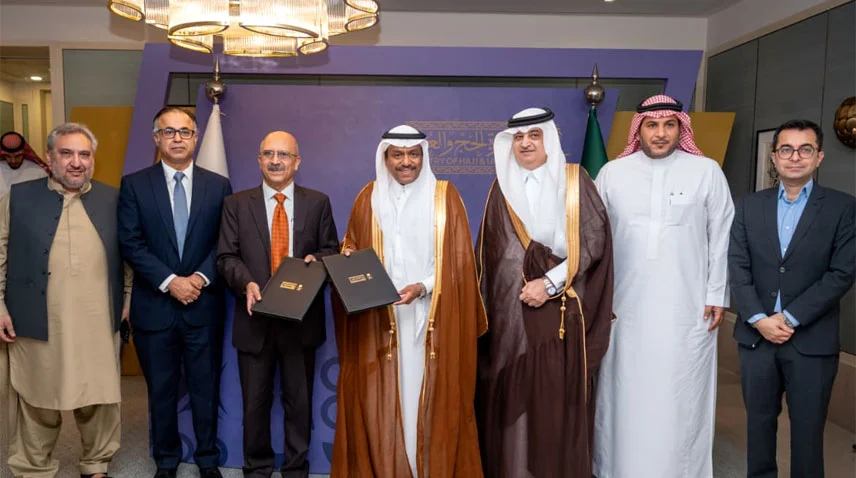The recent agreement signed in Jeddah between Saudi Deputy Minister for Hajj and Umrah Dr. Abdulfattah bin Sulaiman Mashat and Pakistan’s Secretary for Religious Affairs Dr. Syed Ata‑ur‑Rehman marks an important procedural and symbolic step toward Hajj 2026. Beyond the ceremonial signing, the accord underscores two complementary priorities: ensuring pilgrim welfare and strengthening institutional coordination between Islamabad and Riyadh. The Ministry of Religious Affairs’ reaffirmation of timely, high‑quality services for Pakistani pilgrims signals a focus on operational readiness and accountability ahead of next year’s season.
Pakistan Saudi Hajj 2026 Agreement
The signing of the Hajj 2026 agreement in Jeddah between Saudi Deputy Minister for Hajj and Umrah Dr. Abdulfattah bin Sulaiman Mashat and Pakistan’s Secretary for Religious Affairs Dr. Syed Ata‑ur‑Rehman is both procedural and symbolic. It confirms bilateral coordination for the next pilgrimage season and signals a shared commitment to the welfare, safety, and dignity of Pakistani pilgrims. In diplomatic practice, such agreements set expectations for logistics, medical support, accommodation standards, and grievance mechanisms, elements that determine whether a pilgrimage proceeds smoothly or is marred by avoidable disruption.
Quota Recalibration and Rationale
A notable policy change under Hajj Policy 2026 is the redistribution of quotas: 70 percent for the government Hajj scheme and 30 percent reserved for private operators. This rebalancing responds directly to problems observed in 2025, when mismanagement and administrative gaps prevented over 67,000 Pakistanis from performing Hajj despite allocations. By increasing the government share, authorities aim to centralize oversight, improve transparency in beneficiary selection, and ensure more consistent delivery of services to lower‑income and vulnerable pilgrims.
Operational Priorities
Practical implementation will hinge on several operational priorities. Accurate and verifiable beneficiary registries, timely issuance of visas and travel documents, and clear standards for housing and transport must be enforced. Medical screening, on‑site health facilities, and contingency plans for extreme heat or public‑health incidents are essential. The agreement’s text and subsequent operational circulars should also clarify complaint‑resolution channels and independent oversight to build confidence among pilgrims and their families.
Economic and Financial Considerations
Currency stability and predictable remittance channels matter for pilgrimage planning. Recent stability of the Saudi Riyal against the Pakistani Rupee helps reduce financial uncertainty for prospective pilgrims and their sponsors. Government coordination with banks and remittance channels to facilitate exchange, transparent fee structures, and timely release of funds for Hajj logistics will minimize last-minute cost shocks and safeguard pilgrims from exploitative practices.
Diplomatic and Institutional Implications
Beyond logistics, the agreement reaffirms longstanding bilateral ties. Regular, institutionalised Hajj arrangements are a platform for deeper cooperation on consular services, health screening standards, and crisis management. For Pakistan, the recalibrated quota also represents an opportunity to strengthen the Ministry of Religious Affairs’ capacity, through improved data systems, third-party audits, and enhanced provincial coordination, to deliver public services more reliably in future seasons.
Risks and Success Factors
The revised policy reduces some risks but introduces new ones. Centralisation can improve oversight but may also create bottlenecks if administrative capacity is insufficient. Success will depend on early registration drives, digital verification of applicants, transparent allotment criteria, and collaboration with certified private operators to fill niche service gaps. Independent monitoring and accessible grievance redressal will be critical safeguards against the recurrence of past failures.
Recommendations for Effective Implementation
To ensure a transparent, efficient Hajj 2026, authorities should institutionalize digital registration and biometric verification to prevent duplication and guarantee fair allotment; publish clear timelines for document issuance and travel milestones so pilgrims can plan with confidence; and strengthen medical preparedness through pre-departure vaccinations, on-site clinics, and heat‑stroke contingency plans. Where state capacity is constrained, accredited private operators can be engaged under performance-based contracts to fill service gaps while maintaining accountability.
An independent audit of the 2025 shortfalls should be commissioned and its lessons published to promote transparency and institutional learning. Finally, maintaining regular diplomatic channels with Saudi counterparts will be essential to resolve operational issues promptly and coordinate consular, health, and logistical arrangements, thereby safeguarding pilgrims’ welfare and restoring public trust.
Conclusion
The Hajj 2026 agreement is an opportunity to restore trust and deliver a dignified pilgrimage experience for Pakistani citizens. If the intentions expressed in Jeddah translate into disciplined implementation, backed by transparent procedures, robust medical and logistical planning, and active oversight, the recalibrated quota and renewed bilateral cooperation can mitigate past failures. Practically oriented reforms and steady diplomacy can transform the ritual obligation of Hajj into a model of effective public service delivery and international collaboration.
Also Read: Aqeedah Wasitiyyah: The Ultimate Academic Masterpiece by Imam Ibn Taymiyyah (رحمہ اللہ)



